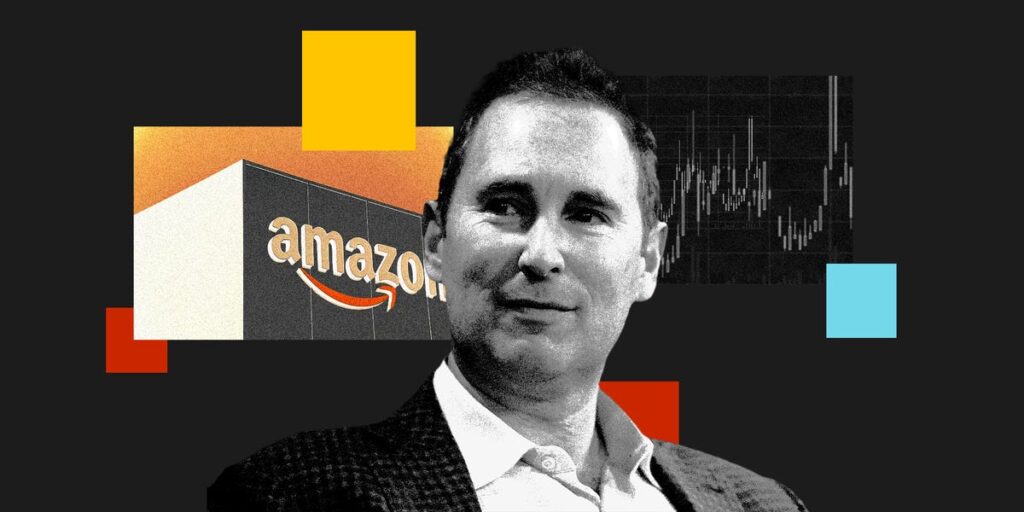- Amazon’s cash balance is expected to reach almost $400 billion by 2027, far outpacing tech rivals.
- This cash gusher stems from record profits, cost-cutting, and success in cloud and advertising.
- Shareholders will want some of this money. So far, Amazon is investing in AI and other growth plans.
Amazon’s ballooning cash balance is drawing Wall Street’s attention.
The company is on pace to have $127.4 billion in cash and short-term investments by the end of this year, tripling the amount from 2018 and surpassing $100 billion for the first time, according to consensus estimates compiled by S&P Global Market Intelligence.
That would give Amazon more money than rivals Alphabet and Microsoft, each expected to have about $112.8 billion and $108.1 billion in cash by that time, respectively. The data showed that even Apple, which puts some of its cash in long-term securities, would fall behind Amazon by next year.
By 2027, Amazon is forecast to have almost $400 billion in cash, far outpacing its Big Tech rivals.
This is an astounding transformation for a company that is famous for running on thin margins, reinvesting most of its profits, and holding relatively little cash compared to peers.
Wall Street is closely following this and questioning whether Amazon plans to return some of its cash in the form of buybacks or dividends. When cash balances surged at other Big Tech companies in the past, the pressure mounted and they started returning some of the money to shareholders.
Mark Mahaney, a tech analyst at Evercore, said he has asked Amazon about shareholder returns for years, but it doesn’t appear to be a “near-term priority” at this point.
Still, he was struck by the sheer size of the company’s growing cash hoard.
“It’s hard to see why Amazon would need THAT MUCH cash on its balance sheet,” Mahaney wrote in an email to BI. An Amazon spokesperson declined to comment.
Pressure to return
Amazon’s cash increase is largely being driven by record profits from cloud computing, advertising, and improved efficiency, including cutting costs.
The company’s free cash flow is expected to nearly double from $36.8 billion last year to $70.8 billion in 2025, according to estimates compiled by S&P Global Market Intelligence.
Hopes for an Amazon dividend or at least more share buybacks gained traction in recent quarters after other tech companies, including Alphabet, Meta, and Salesforce, started returning more of their cash to shareholders earlier this year. Apple and Microsoft have paid dividends for years.
Evercore’s Mahaney said the chances of an Amazon dividend are “pretty low” for the next 2 to 3 years. He thinks a sustained share buyback program is more likely to happen first. Amazon approved a $10 billion stock repurchase plan in 2022, but hasn’t added to this since.
Mark Shmulik, an analyst at Bernstein, told BI that Amazon’s expected free cash flow for the next few years is “significant,” and investors are “certainly asking” for some type of return.
Morgan Stanley, in a note published this week, also said Amazon’s growing cash balance “creates a higher probability of capital returns” next year.
Gene Munster at Deepwater Asset Management told BI that demands for shareholder returns will likely increase next year when he expects investors will become more confident about Amazon’s ability to maintain its pile of cash. Despite the “remarkable” growth in Amazon’s cash balance, the company hasn’t been as aggressive as other tech companies in rewarding shareholders, he noted.
“A year from now, I think there’ll be a lot of pressure for Amazon to do more,” Munster said.
AI is the wild card
Investors have reasons to be happy about Amazon’s performance. Its stock is up roughly 40% in the past year, outpacing the broader market. CEO Andy Jassy’s turnaround efforts have resulted in record profits and renewed investor confidence.
During an April call with analysts, Amazon CFO Brian Olsavsky addressed the question about shareholder returns. He said the company had nothing to say at that point, adding the priorities are growth opportunities and long-term investments, as well as debt repayment. Jassy wrote in his annual shareholder letter that Amazon will continue to invest in artificial intelligence, its nascent Kuiper satellite network, and Prime Video content.
Any large acquisition may be off the table for now, given the tough regulatory environment. The Federal Trade Commission, for example, terminated Amazon’s proposed acquisition of iRobot earlier this year.
Artificial intelligence could be a wild card. Amazon is in an arms race for AI supremacy against Microsoft, Alphabet, OpenAI, and Meta, putting more pressure on the company to invest in the space. In August, Olsavsky said capital expenditures will increase in the second half of this year — up from an eye-watering $30.5 billion in the first half of 2024.
Deepwater’s Munster said depending on how the AI battle plays out, investors could give Amazon more room to invest, rather than rewarding shareholders. AWS’s growth rate has bounced back in recent quarters, and competition with Microsoft is only intensifying, he added.
“If AWS continues to accelerate growth, investors will say, ‘Let’s keep funding this,'” Munster said.
Do you work at Amazon? Got a tip?
Contact the reporter, Eugene Kim, via the encrypted-messaging apps Signal or Telegram (+1-650-942-3061) or email (ekim@businessinsider.com). Reach out using a nonwork device. Check out Business Insider’s source guide for other tips on sharing information securely.


